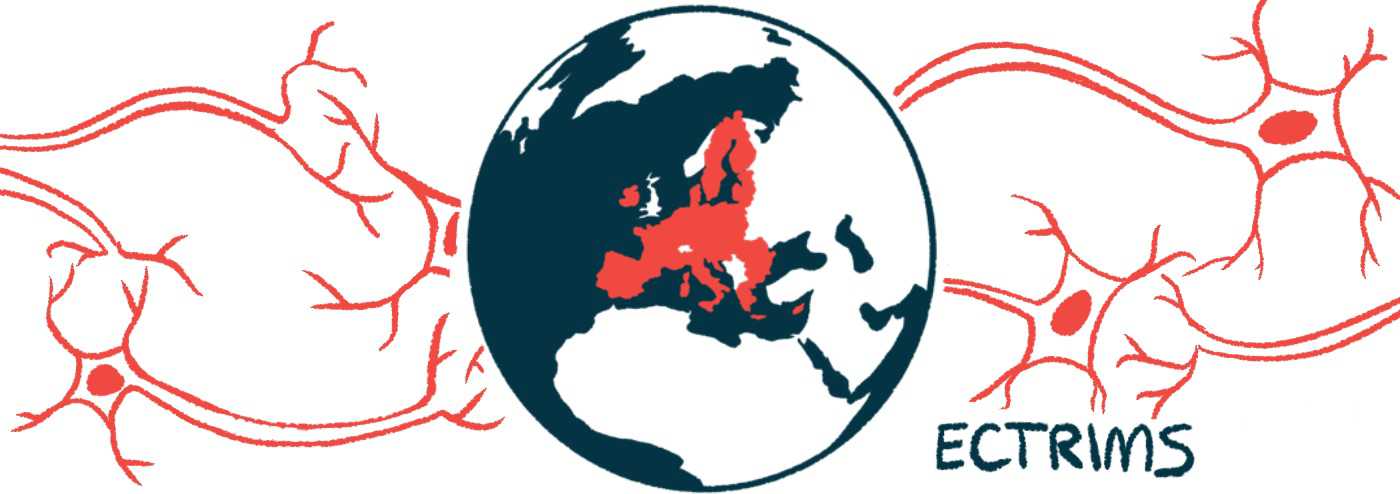#ECTRIMS2022 – Study Examines Ocrevus Use Before, During Pregnancy
The MS therapy does not increase risk of complications, findings show

Treatment with Ocrevus (ocrelizumab) before or during pregnancy does not seem to increase the risk of major pregnancy or infant complications, with 79% of the pregnancies leading to live births, according to data from more than 2,000 women with multiple sclerosis (MS).
The results were shared at the 38th Congress of the European Committee for Treatment and Research in Multiple Sclerosis (ECTRIMS), being held Oct. 26–28 both virtually and in Amsterdam, the Netherlands.
Celia Oreja-Guevara, MD, head of the MS Center at University Hospital San Carlos, in Madrid, Spain, gave the oral presentation, “Pregnancy and infant outcomes in women receiving ocrelizumab for the treatment of multiple sclerosis.”
Marketed by Roche’s subsidiary Genentech, Ocrevus is an MS antibody therapy approved for relapsing forms of the disease and for primary progressive MS. Administered directly into the bloodstream twice yearly, it works by targeting the CD20 protein at the surface of B-cells — a type of immune cell implicated in MS — and leading to their death.
As of March, more than 250,000 MS patients around the world had started Ocrevus treatment, and the number of women exposed to the therapy “before, during, and after the pregnancy is increasing,” said Oreja-Guevara, who is also vice chair of neurology at the University Hospital San Carlos.
Based on safety concerns, the U.S. Food and Drug Administration currently recommends that pregnancy be avoided for at least six months after an Ocrevus infusion. In the European Union, the recommended interval is at least one year.
Now, Oreja-Guevara and colleagues, along with Roche, evaluated pregnancy and infant outcomes in women with MS treated with Ocrevus by analyzing data from the Roche Global Safety Database.
Maternal exposure was defined as receiving one or more Ocrevus doses before the last menstrual period or during pregnancy. Fetal exposure was considered when the last infusion was within three months prior to the last menstrual period or during pregnancy.
From November 2008 to March 2022, a total of 2,020 pregnancies were reported among women with MS exposed to Ocrevus — a 65% increase relative to last year’s data cut-off date.
Participants had a median of 32 years at the time of their last menstrual period before pregnancy. About a third (34.9%) of reported pregnancies had fetal exposure, 21.4% had no fetal exposure, and for 43.7%, exposure timing was unknown.
Reporting prospectively
Most pregnancies were reported prospectively (74.1%), meaning that outcomes were unknown at the time of first notification. At the latest assessment, outcomes were known for 52.7% of all pregnancies.
Of the 1,498 prospectively reported pregnancies, which were the focus of the presentation, 596 had known outcomes. Of these, 286 pregnancies had fetal exposure to Ocrevus, 163 had no fetal exposure, and 147 were unclear for exposure timing.
Results showed that most pregnancies (79%) resulted in live births, with comparable rates between exposed and non-exposed pregnancies (78.7% vs. 84%).
The slightly lower rate of live births with fetal exposure to Ocrevus may be partially due to the higher rate of elective abortions (11.5% vs. 3.7%). According to Oreja-Guevara, the higher number of elective terminations may be explained by women being afraid of the outcomes due to receiving Ocrevus shortly before or during pregnancy.
Still, despite the increased number of reported Ocrevus-exposed pregnancies compared with last year, the rate of elective abortions dropped from 15.7% to 11.5%, she noted. This is “probably because we have more knowledge,” Oreja-Guevara said, and patients and physicians “are [no longer] afraid,” as “in many cases [Ocrevus] is a very safe treatment.”
More than half (57.1%) of all live births were delivered at full term, and only 10% were born prematurely, or preterm — a rate comparable to that reported for the general population, Oreja-Guevara noted.
The total rate of spontaneous abortions (11.2%) also was within the normal range for certain healthy populations, such as that of Spain. One stillbirth (0.2%; fetal death after 20 weeks of pregnancy) was reported.
Importantly, pregnancies with and without fetal exposure to Ocrevus showed similar rates of full-term (60.9% vs. 63%) and preterm births (9.3% vs. 10.9%), ectopic pregnancies (1.4% vs. 1.8%), and spontaneous abortions (8% vs. 10.4%). Ectopic pregnancies refer to those when a fetus implants outside of the uterus.
Data from both prospective and retrospective cases showed that only 10 of 1,064 pregnancies (0.9%) resulted in major congenital anomalies: eight in the fetal-exposed group, and two in the unknown-exposure group.
This is lower than the 2–3% of all children born in Europe annually who will have such defects, and the distribution of the defect types was similar to that of the healthy population.
Largest dataset
“This is the largest dataset of pregnancy outcomes for an anti-CD20 therapy in MS,” the researchers wrote.
Despite the increasing number of Ocrevus-exposed pregnancies, the “cumulative data do not suggest an increased risk of preterm birth, [major congenital anomalies] or other adverse outcomes with [Ocrevus fetal] exposure and are consistent with epidemiological data,” the researchers wrote.
The researchers now are following 61 babies from these Ocrevus-exposed pregnancies for one year to assess rates of infections and hospitalizations, their breastfeeding status, B-cell levels, and vaccinations. Results are expected to be presented when more data are available.
Notably, pregnancy and infant outcomes continue to be collected in the Ocrevus Pregnancy Registry. Two Phase 4 studies are assessing infant outcomes: MINORE (NCT04998812) for Ocrevus exposure before or during pregnancy and SOPRANINO (NCT04998851) for exposure via breastfeeding. The studies are still enrolling, according to a Genentech press release.
Note: The Multiple Sclerosis News Today team is providing in-depth coverage of the ECTRIMS Forum 2022 Oct. 26-28. Go here to see the latest stories from the conference.







